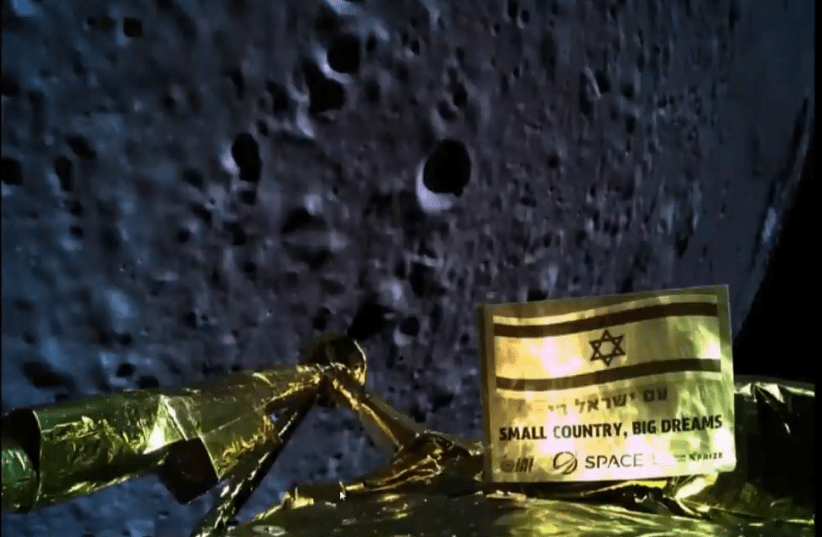Israel almost succeeded in rewriting lunar history on Thursday evening but fell short after spacecraft Beresheet (Hebrew for Genesis) failed to land safely on the Moon.Millions around the world tuned in live to watch the SpaceIL vessel, carrying an Israeli flag and a nano-Bible, descend to the Moon’s Mare Serenitatis (Sea of Serenity) as the State of Israel sought to become only the fourth member of a prestigious club of nations to complete the formidable task of landing a spacecraft on the lunar surface.SpaceIL lost contact with the spacecraft only minutes before it was due to complete the historic landing – a feat previously achieved only by the United States, Russia (then the USSR) and China – after an epic seven-week, 6.5 million km. journey since Beresheet, an ambitious project developed by SpaceIL and Israel Aerospace Industries (IAI), blasted off from Cape Canaveral, Florida on board a SpaceX rocket on February 22. For 48 days, Beresheet’s ground crew watched, monitored and executed every maneuver of the spacecraft from a control center at IAI’s Yehud headquarters.Once in position to descend, the landing maneuver – split into two phases of decreasing horizontal velocity and then vertical velocity – commenced but failed to land after contact was lost with the spacecraft's main engine, leading to a loss of altitude and subsequent crash landing.According to initial assessments, one of the spacecraft's inertial measurement units (IMUs) failed during the final effort. A full investigation will now begin.“If at first you don’t succeed, you try and try again – and we’ll try again,” said Prime Minister Benjamin Netanyahu at the control center.“We reached the moon, but we wanted to land more safely. The attempt alone is a huge achievement. An Israeli satellite will one day land on the moon.”On the wall of the control center, overlooking the scientists behind the project, a plaque read, “The people of Israel live. A small country, big dreams,” summing up the spirit of the endeavor. Unlike all other countries to reach the moon, SpaceIL’s achievement was funded almost entirely by private donors rather than the government.“Where we got to was very tremendous and we can be very proud,” said SpaceIL chairman and lead donor Morris Kahn.The spacecraft was designed to photograph its landing site and snap a selfie. Its key scientific mission, however, was to measure the Moon’s magnetic field as part of an experiment carried out in collaboration with Rehovot’s Weizmann Institute of Science.NASA also participated in the mission and installed a laser retro-reflector on the spacecraft to assist with communication after landing. That communication system enabled the spacecraft to transmit a picture of the moon from only 22 km. altitude ahead of the ill-fated landing."I want to turn to the kids that might be watching - yes, we didn't reach the moon in one piece but engineering and sciences are hard," said Yehonatan Weintraub."Sometimes it doesn't work the first, second, third or even fourth time, but eventually it will work. I want to encourage you to continue studying engineering and sciences, because one day you will be able to reach the moon, the stars and beyond."Beresheet was the smallest spacecraft ever constructed in an attempt to reach the moon, measuring 1.5 meters high, two meters wide and weighing 600 kg. Fuel represented approximately 75% of its payload. The mission budget stood at about NIS 350 million, far less than the other three countries spent when they undertook such a mission.The spacecraft also carried an Israeli flag and time capsule on its journey, containing hundreds of digital files, cultural items and materials collected by the SpaceIL crew and the general public.The motivation to inspire younger generations to pursue scientific studies, Israel’s version of the “Apollo Effect,” has remained constant since the beginning of SpaceIL’s endeavor eight years ago, when co-founders Weintraub, Yariv Bash and Kfir Damari enrolled in the Google Lunar X Prize challenge.While the race ended with no winner in March 2018, SpaceIL continued with its mission to reach the Moon. That mission ended in failure on Thursday, but SpaceIL still proved that the sky truly is not the limit for a small group of Israelis and supporters brave enough to break through it.
On verge of space history, Beresheet fails to land safely on Moon
The State of Israel fell just short of becoming only the fourth member of a prestigious club of nations to complete the formidable task of landing a spacecraft on the lunar surface.
